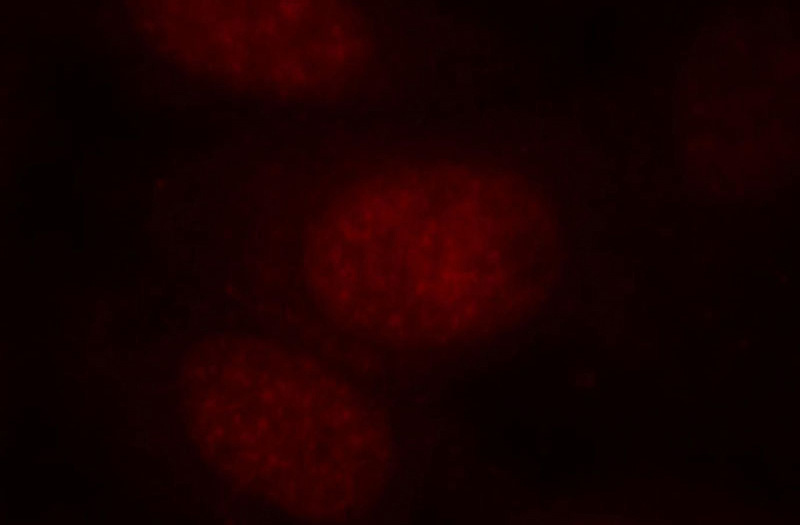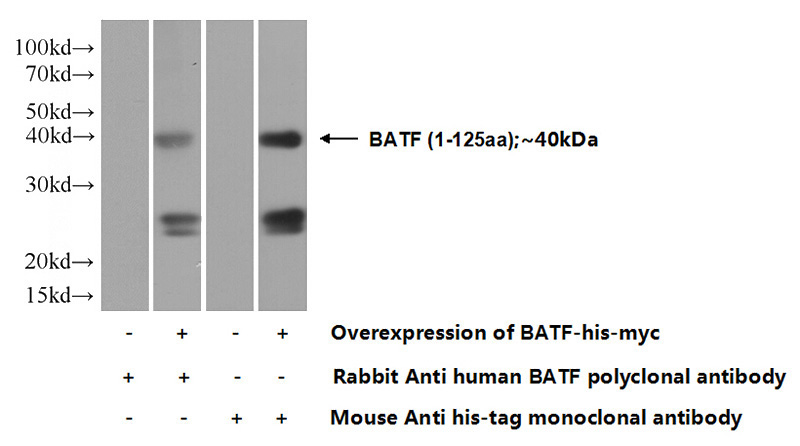-
Product Name
BATF antibody
- Documents
-
Description
BATF Rabbit Polyclonal antibody. Positive WB detected in Transfected HEK-293 cells. Positive IF detected in HepG2 cells, Hela cells.
-
Tested applications
ELISA, IF, WB
-
Species reactivity
Human,Mouse,Rat; other species not tested.
-
Alternative names
B ATF antibody; BATF antibody; BATF1 antibody; SF HT activated gene 2 protein antibody; SFA 2 antibody; SFA2 antibody
-
Isotype
Rabbit IgG
-
Preparation
This antibody was obtained by immunization of BATF recombinant protein (Accession Number: NM_006399). Purification method: Antigen affinity purified.
-
Clonality
Polyclonal
-
Formulation
PBS with 0.02% sodium azide and 50% glycerol pH 7.3.
-
Storage instructions
Store at -20℃. DO NOT ALIQUOT
-
Applications
Recommended Dilution:
WB: 1:500-1:5000
IF: 1:10-1:100
-
Validations

Immunofluorescent analysis of HepG2 cells, using BATF antibody Catalog No:108362 at 1:25 dilution and Rhodamine-labeled goat anti-rabbit IgG (red).

Transfected HEK-293 cells were subjected to SDS PAGE followed by western blot with Catalog No:108362(BATF Antibody) at dilution of 1:1000
-
Background
basic leucine zipper transcription factor (BATF), also named B-cell-activating transcription factor, SF-HT-activated gene 2 protein. AP-1 family transcription factor that controls the differentiation of lineage-specific cells in the immune system: specifically mediates the differentiation of T-helper 17 cells (Th17), follicular T-helper cells (TfH), CD8(+) dendritic cells and class-switch recombination (CSR) in B-cells. Acts via the formation of a heterodimer with JUNB that recognizes and binds DNA sequence 5'-TGA[CG]TCA-3'. The BATF-JUNB heterodimer also forms a complex with IRF4 (or IRF8) in immune cells, leading to recognition of AICE sequence (5'-TGAnTCA/GAAA-3'), an immune-specific regulatory element, followed by cooperative binding of BATF and IRF4 (or IRF8) and activation of genes. Controls differentiation of T-helper cells producing interleukin-17 (Th17 cells) by binding to Th17-associated gene promoters: regulates expression of the transcription factor RORC itself and RORC target genes such as IL17 (IL17A or IL17B). Also involved in differentiation of follicular T-helper cells (TfH) by directing expression of BCL6 and MAF. In B-cells, involved in class-switch recombination (CSR) by controlling the expression of both AICDA and of germline transcripts of the intervening heavy-chain region and constant heavy-chain region (I(H)-C(H)). Following infection, can participate to CD8(+) dendritic cell differentiation via interaction with IRF4 and IRF8 to mediate cooperative gene activation. Regulates effector CD8(+) T-cell differentiation by regulating expression of SIRT1. Following DNA damage, part of a differentiation checkpoint that limits self-renewal of hematopoietic stem cells (HSCs): up-regulated by STAT3, leading to differentiation of HSCs, thereby restricting self-renewal of HSCs. The molecular mass of BATF is 14kd.
-
References
- Ma L, Li J, Wang G. Atrial natriuretic peptide suppresses Th17 development through regulation of cGMP-dependent protein kinase and PI3K-Akt signaling pathways. Regulatory peptides. 181:9-16. 2013.
Related Products / Services
Please note: All products are "FOR RESEARCH USE ONLY AND ARE NOT INTENDED FOR DIAGNOSTIC OR THERAPEUTIC USE"
